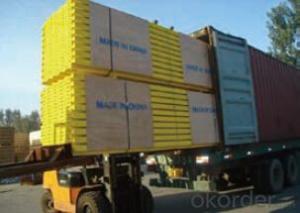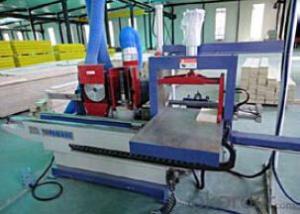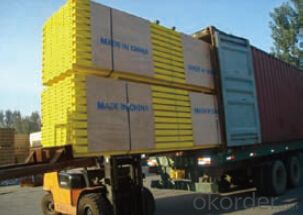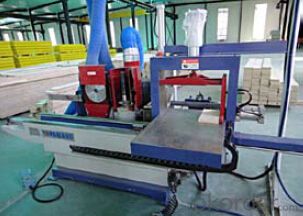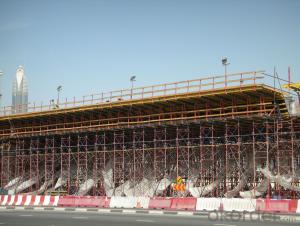Timber beam H-20 for formwork and scaffolding system
- Loading Port:
- Tianjin
- Payment Terms:
- TT OR LC
- Min Order Qty:
- 50 m²
- Supply Capability:
- 1000 m²/month
OKorder Service Pledge
OKorder Financial Service
You Might Also Like
Characteristics:
◆ Standardized production lines.
Supply capability: 3000m/day, Lmax = 6600mm.
◆ Finger jointing of the flange and web, the strength of timber beam is highly improved.
Max. shearing force failure load:40KN
◆ Well treated to prevent from water penetration or erosion, so the service life maximally extended.
Normally, CNBM timber beam H20 can be used for 4 to 5 years, the exact using time would depend on maintenance & storage.
◆ Robust caps at the end of the girders protect against damages.
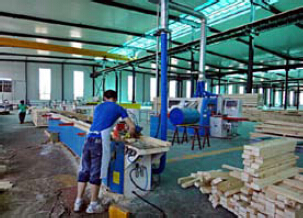
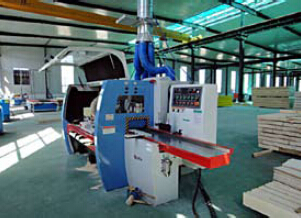
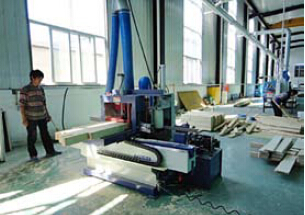
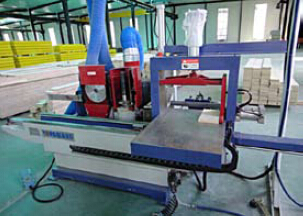
- Q: How does steel formwork contribute to the overall structural integrity of a building?
- Steel formwork contributes to the overall structural integrity of a building by providing a strong and rigid framework for pouring concrete. It ensures accurate alignment and dimensional stability, resulting in consistent and reliable construction. The use of steel formwork also enhances the load-bearing capacity of the structure, allowing it to withstand heavy loads and external forces. Additionally, steel formwork offers excellent durability and longevity, reducing the risk of structural failures over time.
- Q: How does steel formwork handle different concrete surface reflectivity?
- Steel formwork is highly versatile and can easily handle different concrete surface reflectivity. The smooth and rigid nature of steel allows it to provide a consistent and even surface for concrete placement, regardless of the reflectivity of the concrete. This ensures that the concrete surface is uniform and free from any distortions or irregularities caused by variations in reflectivity. Additionally, steel formwork can be adjusted or modified to accommodate specific requirements, providing a reliable solution for handling different concrete surface reflectivity.
- Q: What are the common challenges faced during steel formwork installation?
- Some common challenges faced during steel formwork installation include ensuring proper alignment and leveling of the formwork, handling heavy and bulky steel components, securing the formwork against displacement during concrete pouring, and maintaining structural stability and integrity throughout the installation process. Additionally, coordinating with other construction activities, such as rebar placement and concrete pouring, can also be a challenge to ensure smooth and timely progress of the formwork installation.
- Q: What are the different material handling requirements for steel formwork?
- The different material handling requirements for steel formwork involve proper storage, lifting, transportation, and maintenance of the steel components. Steel formwork should be stored in a dry and secure area, away from moisture and exposure to the elements. When lifting, it is essential to use appropriate lifting equipment and follow proper rigging procedures to ensure the safety of workers and prevent damage to the formwork. During transportation, the steel formwork should be securely fastened and protected from any potential impacts or vibrations. Regular maintenance, including cleaning, inspection, and repair, is crucial to ensure the longevity and performance of the steel formwork.
- Q: How does steel formwork affect the overall construction schedule and sequencing?
- The overall construction schedule and sequencing can be significantly affected by steel formwork. Several advantages of steel formwork, compared to traditional wooden formwork, contribute to faster construction times and improved sequencing. To begin with, steel formwork is highly durable and strong, allowing for multiple reuses without any degradation. This durability reduces assembly and dismantling time, resulting in faster construction progress. Furthermore, the robustness of steel formwork allows for higher pouring rates, enabling larger sections of concrete to be poured at once. As a result, productivity is increased, and construction schedules are shortened. In addition, steel formwork provides greater accuracy and precision in shaping concrete structures. The easily adjustable and alignable steel panels and frames ensure correct positioning and leveling of the forms. This precision significantly reduces the time needed for adjustments or rework, thus improving sequencing and minimizing delays. Moreover, steel formwork offers flexibility in design and customization. It can be easily modified or adapted to suit different construction requirements and building designs. This flexibility allows for a smoother construction process, eliminating the need for extensive modifications or alterations and saving time while enhancing sequencing. Furthermore, steel formwork can withstand harsh weather conditions and extreme temperatures, making it suitable for various construction environments. This resilience eliminates delays caused by adverse weather, allowing construction to proceed as scheduled. Overall, the use of steel formwork has a positive impact on the construction schedule and sequencing. Its durability, accuracy, flexibility, and resilience contribute to faster construction progress, reduced rework, improved productivity, and minimized delays. By utilizing steel formwork, construction projects can be completed more efficiently and within the planned timeframe.
- Q: Are there any special considerations when using steel formwork in cold weather conditions?
- Yes, there are several special considerations when using steel formwork in cold weather conditions. Firstly, steel can become brittle at low temperatures, so it is important to ensure that the formwork is adequately heated to prevent cracking or structural failures. Additionally, cold temperatures can affect the curing process of concrete, so it is necessary to use temperature-controlled curing techniques and ensure proper insulation of the formwork. Lastly, freezing temperatures can cause ice to form on the formwork, which may affect the quality of the finished concrete. Therefore, it is crucial to regularly inspect and remove any ice buildup to maintain the integrity of the steel formwork.
- Q: Can steel formwork be used for both manual and mechanical concrete pouring?
- Indeed, both manual and mechanical concrete pouring can utilize steel formwork. Renowned for its robustness and sturdiness, steel formwork is apt for handling the immense pressure and weight of concrete, regardless of the pouring method employed. It furnishes a steadfast and inflexible framework that endures the strains exerted during the pouring and setting of concrete. Moreover, steel formwork is adaptable and can be effortlessly modified or reconstructed to accommodate diverse configurations and dimensions of concrete structures. Consequently, it is frequently employed in construction ventures that employ both manual and mechanical concrete pouring techniques.
- Q: Can steel formwork be used for both standard and non-standard concrete sections?
- Yes, steel formwork can be used for both standard and non-standard concrete sections. Steel formwork offers versatility and flexibility in shaping different types of concrete sections, allowing for the creation of various shapes and sizes. Its durability and strength make it suitable for use in both standard and non-standard concrete construction projects.
- Q: How does steel formwork handle different concrete reinforcement types?
- Steel formwork is a versatile and durable option for handling different types of concrete reinforcement. It is commonly used in construction projects to create temporary molds or structures to hold concrete in place during the pouring and curing process. One of the advantages of steel formwork is its ability to handle different concrete reinforcement types. Whether it is traditional reinforcement such as steel bars or modern reinforcement techniques like fiber-reinforced polymers (FRP), steel formwork can accommodate them all. Steel formwork is designed to be strong and rigid, which allows it to support the weight and pressure exerted by different types of reinforcement materials. Whether it is the weight of steel bars or the tensile strength of FRP, steel formwork can withstand these forces without deforming or collapsing. Additionally, steel formwork is highly adaptable and can be easily adjusted or modified to accommodate different reinforcement types. It can be cut or welded to create openings or recesses for steel bars or other reinforcement materials to pass through. This flexibility ensures that steel formwork can be customized to suit the specific needs of each construction project. Furthermore, steel formwork offers a smooth and even surface finish, which is crucial for ensuring proper adhesion between the concrete and the reinforcement materials. This ensures that the reinforcement is securely embedded within the concrete structure, providing the necessary structural integrity and strength. In conclusion, steel formwork is a reliable and effective solution for handling different concrete reinforcement types. Its strength, adaptability, and ability to provide a smooth surface finish make it an ideal choice for construction projects that require diverse reinforcement materials.
- Q: What are the different types of steel used in formwork construction?
- Formwork construction utilizes various types of steel, each possessing distinct characteristics and applications. 1. Mild Steel: The most frequently employed steel in formwork construction, mild steel offers affordability, availability, and ease of handling. It is suitable for numerous formwork applications, boasting commendable strength and durability. 2. High Tensile Steel: Distinguishing itself from mild steel, high tensile steel exhibits superior strength and tensile properties, rendering it ideal for robust formwork structures. Its ability to resist bending and deformation under heavy loads makes it particularly fitting for extensive construction projects. 3. Reinforcing Steel: Also referred to as rebar, reinforcing steel reinforces concrete structures in formwork construction. Typically composed of carbon steel, it comes in various grades and sizes. Reinforcing steel is employed to enhance concrete's tensile strength, diminish cracking, and prevent structural failure. 4. Stainless Steel: When prioritizing resistance to corrosion, formwork construction turns to stainless steel. This material excels in environments with harsh conditions or exposure to corrosive substances. Its exceptional resistance to corrosion results in a long-lasting and durable choice for formwork construction. 5. Alloy Steel: Utilized in formwork construction for its augmented properties, alloy steel combines with other elements to enhance its characteristics. This type of steel is commonly employed for its high strength, toughness, and resistance to wear and tear. Formwork systems requiring outstanding performance and durability often rely on alloy steel to withstand substantial loads. Ultimately, the selection of steel for formwork construction hinges upon project-specific requirements, encompassing load-bearing capacity, durability, and corrosion resistance. The appropriate type of steel must be chosen to guarantee the safety and longevity of the formwork structure.
Send your message to us
Timber beam H-20 for formwork and scaffolding system
- Loading Port:
- Tianjin
- Payment Terms:
- TT OR LC
- Min Order Qty:
- 50 m²
- Supply Capability:
- 1000 m²/month
OKorder Service Pledge
OKorder Financial Service
Similar products
Hot products
Hot Searches
Related keywords
